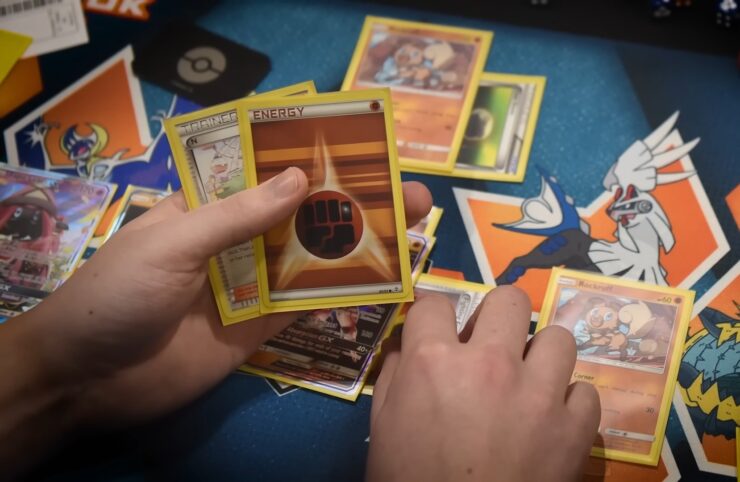It’s been quite a while since Pokemon TCG was first released in Japan and, then, worldwide (20th October, 1996 and 9th January, 1999, respectively).
However, still, the popularity of the game is yet to be diminished. Even after 27 years, many people, like us, are coming back to the game – whether in their search for glory or to collect a part of their childhood. But, the question is – how do you play the game?
Contextually speaking, albeit Pokemon TCG is somewhat easy to play, it still has a learning curve that you must get accustomed to. Also, there’s the context of deck-building, using lots of combos, and being competitive as a whole.
So, before you get too excited, I’d suggest you go through our guide to TCG Pokemon once. It will certainly help you get a headstart and win a game or two in the long run.
Pokemon TCG – The Deck-Building Basics
When it comes to playing Pokemon Trading Card Game, you will always need a deck to get started with. Generally, an experienced player would build more than one deck, with each of them having a different set of Pokemons and strategies. However, as a new player, only having a single deck can be a great starting point.
And, while you’re at it, you must ensure that your deck is well-constructed and doesn’t have any apparent shortcomings. But, we’ll talk more about that later. For now, let’s understand the basics of creating a deck for Pokemon TCG.
To begin with, your deck needs to have 60 cards – not more, not less. In addition, you cannot add more than four Pokemon cards of the same name. However, the only exception to this rule is the energy cards. You may have as many as you want, as long as the number of cards you have is within the limit of 60.
Also, if you’re playing in a competitive tournament, you must consider the banned cards too. This is usually done so that the balance of the tournament doesn’t topple at all.
Making the Very First Pokemon TCG Deck
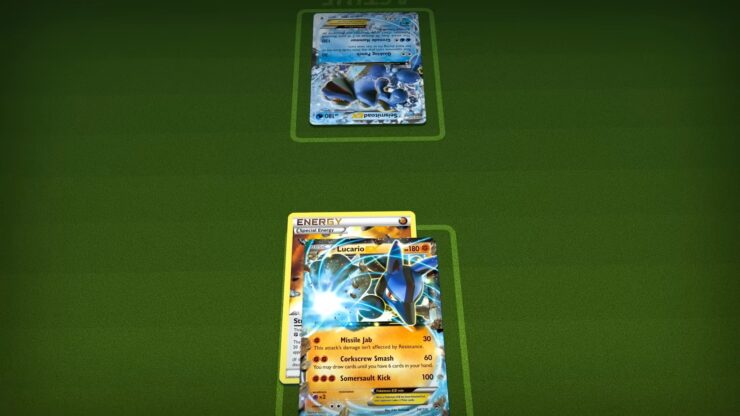
So, as you know the fundamental rules of deck-building in Pokemon TCG, now you’re ready to create a deck of your own. Here are some tips you may follow regarding the same.
1: Get Your “Playing Strategy” Straight
Almost every player has their own playing strategy, and they must create a deck accordingly to stick to the same. For example, if you’re opting for an aggressive playstyle, you’ll need to get some cards that can knock your opponent out quickly. Conversely, a Control deck will heavily rely on manipulating the battlefield and cutting the progress of your opponent.
A Mill deck, on the other hand, is all about forcing your rival to discard different cards from their deck. Your goal, here, will be to ensure that your enemy’s cards are running out. Once they are decked out, they will lose the game automatically. Finally, a Stall deck will primarily focus on delaying your opponent’s opportunities of knocking you out. It can be done by using a lot of tanky Pokemons or by reducing damage.
2: The Deck Should be Centered Around One Attacker
Even though it may not seem so at the beginning, an attacker Pokemon card can rely heavily on important resources. So, if you want to win the game flawlessly, you’ll have to figure out how you can use it more imposingly. Usually, when we create a Pokemon TCG deck, we include two types of attackers in it –
-
Main Attacker
It’s going to be the heaviest hitter of your deck or the one who can facilitate how your game strategy is going to play out. Thus, it is best if you have more than one copy of the same and build your deck in accordance with it.
For example, if you want to use the Charizard TCG card, it might be best to have four copies of it. Ensure that you’ve assembled all of its family, including Charmander and Charmeleon.
-
Secondary Attacker/s
If you are playing against an advanced opponent, it might not be easy for your main attacker to win the game for you. That is why you need to have at least one card, AKA the secondary attackers, that can strike down your foes quickly.
The secondary attackers of your deck must possess the same playstyle as your main attacker, or offer decent support to them.
3: Don’t Go Overboard with the Trainer Cards
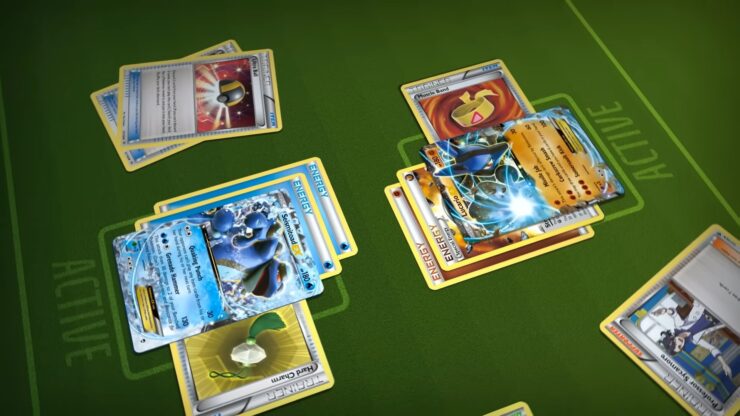
Almost every Pokemon TCG pack, such as the scarlet violet booster box, will feature quite a few trainer cards. And each of them will come with a specific element that can improve your overall strategy even more and help you win the game.
But, remember – a player can only use a specific number of Trainer cards per turn. So, if you keep a lot of them in your deck, there’s a high chance that they’ll go to waste. Also, there are different types of trainer cards available in the game.
So, you have to use them accordingly to get the best out of them –
- Supporter: These tend to be incredibly powerful, as they can provide wide-reaching effects that can turn the tide of any Pokemon TCG game. However, you can only use them once per turn. So, be careful with what you have in your hands.
- Stadium: These represent the environment where the battle is taking place. Thus, the effect it inflicts will affect both the players. In any case, only a single Stadium can be active per turn. So, if you play one Stadium card, you can overwrite the active one.
- Item: The Item cards generally offer a one-off effect that can boost the damage of a card or reduce its retreating cost. And, the coolest thing about them is that you can use as many of them as needed. But, do you really want to be unarmed for one turn?
How to Play Pokemon TCG: A Basic Outlook
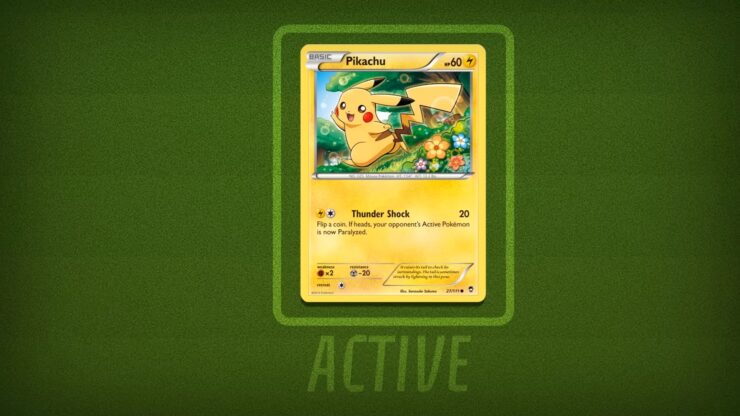
We have segmented it into eight steps and written it in bullet format to make it understandable.
Step 1: Prepare the Deck
- Each player needs a deck of 60 Pokémon cards to play the game. The deck should consist of Pokémon cards, Trainer cards, and Energy cards.
- The Pokémon cards represent the Pokémon you’ll use in battle.
- Trainer cards have various effects that can help you during the game.
- Energy cards provide the necessary energy for your Pokémon to attack.
Step 2: Set Up the Play Area
- Each player should have a clear play area in front of them. This area will be used to place Pokémon cards, Energy cards, and other cards during the game.
- Each player also needs a Prize card area, where they’ll place six Prize cards face-down. These cards will be earned as the game progresses.
Step 3: Shuffle and Draw Cards
- Shuffle your deck thoroughly and draw seven cards as your starting hand.
- If you don’t have any Basic Pokémon cards in your hand, you must mulligan (reshuffle your hand into your deck) and draw a new hand of six cards. Repeat this process until you have a Basic Pokémon card in your starting hand.
Step 4: Determine Who Goes First
- Both players flip a coin, and the winner decides who goes first.
- The player who goes first cannot attack their first turn but can perform other actions.
Step 5: Set Up Pokémon
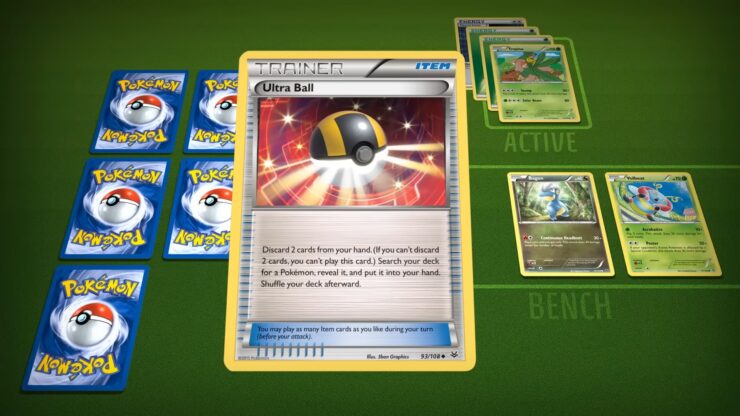
- Each player can play one Basic Pokémon card from their hand on the Bench, which is a separate area beside the play area.
- You can have up to five Pokémon on the Bench, but your Active Pokémon is the only one you can attack with.
Step 6: Take Turns
- The game proceeds with players taking turns.
- On your turn, you can do the following actions in any order:
- Draw one card from your deck.
- Attach one Energy card from your hand to one of your Pokémon.
- Play Trainer cards from your hand.
- Evolve your Pokémon by playing an Evolution card on top of a Basic Pokémon.
- Retreat your Active Pokémon (moving it to the Bench) and replace it with another Active Pokémon.
- Use the attacks of your Active Pokémon (if they have enough Energy attached).
- Once you’ve finished your turn, your opponent takes their turn.
Step 7: Attacking and Knocking Out Pokémon
- To attack, you need to have the required Energy attached to your Active Pokémon as specified by the attack cost.
- Different attacks have different effects, such as dealing damage or applying special conditions.
- If your attack’s damage exceeds the defending Pokémon’s HP, it is knocked out. You take one Prize card from your Prize card area and place it face-down as a reward.
Step 8: Winning the Game
- The game continues with players taking turns, attacking, and trying to knock out their opponent’s Pokémon.
- The first player to collect all six Prize cards by knocking out their opponent’s Pokémon wins the game.
- Alternatively, if your opponent has no Pokémon left on their Bench or in play, you win the game.
- Remember that this is just a basic guide, and there are more rules and strategies you can learn as you become more familiar with the Pokémon TCG. Have fun playing!

